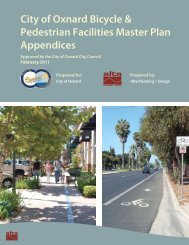View File - Development Services - City of Oxnard
View File - Development Services - City of Oxnard
View File - Development Services - City of Oxnard
Create successful ePaper yourself
Turn your PDF publications into a flip-book with our unique Google optimized e-Paper software.
WATER RESOURCES TECHNICAL REPORTin the model is lower for 2020 (-41.04 inches) than for 2000 (-37.72 inches) as noted inTable 6-2. An equal number <strong>of</strong> 6 dry and 6 wet years occurred during the 20-year simulationperiod between 2000 and 2020. The third quarter 2020 results indicate the following relativeto the third quarter 2000 results:• Water levels are up to 10 feet above sea level in the UAS along the <strong>Oxnard</strong> Plaincoastline, lower when they were for in 2000 (15 to 30 feet above sea level). The waterlevels increase robustly landward for both years, but less steeply for 2020.• Water levels are about 10 feet below sea level in the LAS along the northern <strong>Oxnard</strong>Plain coastline, lower than they were for 2000 (at about sea level). The water levelsdecrease to below sea level landward across most <strong>of</strong> the northern <strong>Oxnard</strong> Plain, lowerthan they were for 2000 (at about sea level inland and increasing in the Forebay area)• Water levels are approximately 45 to 55 feet below sea level in the LAS along thesouthern <strong>Oxnard</strong> Plain coastline and decrease landward to a low <strong>of</strong> about 120 feet belowsea level, lower than they were for 2000 (between about 20 and 30 feet below sea levelalong coastline and decreasing landward to a low <strong>of</strong> approximately 70 feet belowsea level).The historical and Base Case simulated groundwater elevations for the key wells(Figure 6-2) shown in the hydrographs in Figure 6-16 support the lower elevations in 2020relative to 2000. The correlation in historical water levels for the key wells (Figure 6-2) withthe historical 114-year cumulative departure from average precipitation (Figure 6-3) that isshown in Figures 2-14 and 6-3 is also apparent between the future simulated Base Casewater levels and the model cumulative departure from average precipitation used for themodel simulations. This demonstrates the sensitivity <strong>of</strong> the simulated (and historical)groundwater elevations to the cumulative departure from average precipitation.The <strong>Oxnard</strong> Forebay area hydrographs (Figure 6-16, page 1/3) indicate the following:• Both UAS and LAS groundwater levels are significantly above sea level during all years<strong>of</strong> the 31-year simulation period and occasionally drop to near sea level during extendeddrier climatic periods.• The UAS groundwater levels are highest at the northeast area <strong>of</strong> the Forebay (12R01)and in the central area <strong>of</strong> the Forebay (where the spreading grounds occur (23B07). Thewater levels are lowest toward the southwest (22M04) and southern (35C01) areas <strong>of</strong> theForebay.• The LAS groundwater levels drop to slightly below sea level during extended drierclimatic periods (23B05).W112003002SCO LW1458.DOC/ 033390002 85
















